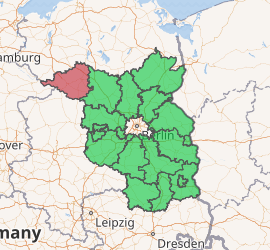Prignitz
Prignitz (German: [ˈpʁiːɡnɪts] (![]()
Prignitz | |
|---|---|
 Coat of arms | |

| |
| Country | Germany |
| State | Brandenburg |
| Founded | 1993 |
| Capital | Perleberg |
| Area | |
| • Total | 2,123 km2 (820 sq mi) |
| Population (31 December 2018)[1] | |
| • Total | 76,508 |
| • Density | 36/km2 (93/sq mi) |
| Time zone | UTC+01:00 (CET) |
| • Summer (DST) | UTC+02:00 (CEST) |
| Vehicle registration | PR |
| Website | landkreis-prignitz.de |
Geography
The term Prignitz originally meant the region north of the confluence of the Elbe and Havel rivers. This region is larger than the district. It also includes the town of Havelberg in Saxony-Anhalt and large portions of the neighbouring district of Ostprignitz-Ruppin.
The Elbe river forms the southwestern border of the district.
History
The historical region Prignitz consisted of the following eleven districts, established in the 13th century: Wittenberge, Lenzen, Perleberg, Putlitz, Kyritz, Nitzow, Wittstock, Pritzwalk, Havelberg, Wusterhausen and Grabow.
The present district of Prignitz was created in 1993 by merging the previous districts of Pritzwalk and Perleberg and a few municipalities from the district Kyritz. The westernmost part of the district was previously part of Mecklenburg-Western Pomerania and became part of Brandenburg on August 1, 1992.
The earlier district of Prignitz was the buffer between Brandenburg and Mecklenburg. It was resettled by Germans, especially from the Bremen area, following the First Wendish Crusade of 1147. The rate of German settlement increased over the following decades. The eastern half was dominated by the pro-German counts von Plotho who brought their own vassals such as the von Blumenthal and von Grabow families with them. The western half was dominated by robber barons, especially the Gans zu Putlitz family and their vassals, the von Quitzows. When Frederick, Count of Zollern was appointed Margrave in 1411, he faced an uprising of the Wendish nobility, supported by the Wendish Duke of Mecklenburg. However, he was able to put down the revolt at the battle of the Cremmer Dam, with the support of the German nobility. Families who had stayed loyal were rewarded. Otto von Blumenthal, for example, was made Captain of the Prignitz from 1415 to 1422 and of Lenzen from 1420.
Demography
 Development of population since 1875 within the current Boundaries (Blue Line: Population; Dotted Line: Comparison to Population development in Brandenburg state; Grey Background: Time of Nazi Germany; Red Background: Time of communist East Germany)
Development of population since 1875 within the current Boundaries (Blue Line: Population; Dotted Line: Comparison to Population development in Brandenburg state; Grey Background: Time of Nazi Germany; Red Background: Time of communist East Germany) Recent Population Development and Projections (Population Development before Census 2011 (blue line); Recent Population Development according to the Census in Germany in 2011 (blue bordered line); Official projections for 2005-2030 (yellow line); for 2014-2030 (red line); for 2017-2030 (scarlet line)
Recent Population Development and Projections (Population Development before Census 2011 (blue line); Recent Population Development according to the Census in Germany in 2011 (blue bordered line); Official projections for 2005-2030 (yellow line); for 2014-2030 (red line); for 2017-2030 (scarlet line)
|
|
|
Coat of arms
 Coat of arms |
The coat of arms shows a goose preparing for flight, the symbol of the Gans zu Putlitz family (Gans is German for goose), who in the 12th century were one of a number of families (such as the von Plotho, von Blumenthal and von Arnim families) who introduced Christianity and German culture to Prignitz. The pearls around the goose symbolize Perleberg (which translates to Pearl Mountain). The wolf at bottom stands for the former administrative seat, Pritzwalk, as walk derives from the Slavonic wolk meaning wolf. The wavy separation between the top and bottom symbolizes the river Elbe; the colors red and white are those of Brandenburg. |
Towns and municipalities
| Amt-free towns | Ämter | |
|---|---|---|
|
|
||
| 1seat of the Amt; 2town | ||
References
- "Bevölkerung im Land Brandenburg nach amtsfreien Gemeinden, Ämtern und Gemeinden 31. Dezember 2018". Amt für Statistik Berlin-Brandenburg (in German). July 2019.
- Detailed data sources are to be found in the Wikimedia Commons.Population Projection Brandenburg at Wikimedia Commons
External links
| Wikimedia Commons has media related to Prignitz. |